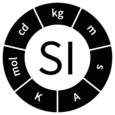Katal
This article may require cleanup to meet Wikipedia's quality standards. The specific problem is: article lacks important detail. (February 2020) |
| katal | |
|---|---|
SI | |
| Unit of | catalysis |
| Symbol | kat |
| In SI base units: | mol/s |
The katal (symbol: kat) is that
The unit 'katal' is not attached to a specified measurement procedure or assay condition, but any given catalytic activity is: the value measured depends on experimental conditions that must be specified.[2][3] Therefore, to define the quantity of a catalyst in katals, the catalysed rate of conversion (the rate of conversion in presence of the catalyst minus the rate of spontaneous conversion) of a defined chemical reaction is measured in moles per second.[4] One katal of trypsin, for example, is that amount of trypsin which breaks one mole of peptide bonds in one second under the associated specified conditions.[clarification needed]
Definition
One katal refers to an amount of enzyme that gives a catalysed rate of conversion of one mole per second.[5][6] Because this is such a large unit for most enzymatic reactions, the nanokatal (nkat) is used in practice.[6]
The katal is not used to express the
SI multiples
| Submultiples | Multiples | ||||
|---|---|---|---|---|---|
| Value | SI symbol | Name | Value | SI symbol | Name |
| 10−1 kat | dkat | decikatal | 101 kat | dakat | decakatal |
| 10−2 kat | ckat | centikatal | 102 kat | hkat | hectokatal |
| 10−3 kat | mkat | millikatal | 103 kat | kkat | kilokatal |
| 10−6 kat | μkat | microkatal | 106 kat | Mkat | megakatal |
| 10−9 kat | nkat | nanokatal | 109 kat | Gkat | gigakatal |
| 10−12 kat | pkat | picokatal | 1012 kat | Tkat | terakatal |
| 10−15 kat | fkat | femtokatal | 1015 kat | Pkat | petakatal |
| 10−18 kat | akat | attokatal | 1018 kat | Ekat | exakatal |
| 10−21 kat | zkat | zeptokatal | 1021 kat | Zkat | zettakatal |
| 10−24 kat | ykat | yoctokatal | 1024 kat | Ykat | yottakatal |
| 10−27 kat | rkat | rontokatal | 1027 kat | Rkat | ronnakatal |
| 10−30 kat | qkat | quectokatal | 1030 kat | Qkat | quettakatal |
History
The General Conference on Weights and Measures and other international organizations recommend use of the katal.[7] It replaces the non-SI enzyme unit of catalytic activity. The enzyme unit is still more commonly used than the katal,[6] especially in biochemistry.[citation needed][8] The adoption of the katal has been slow.[6][9]
Origin
The name "katal" has been used for decades. The first proposal to make it an SI unit came in 1978,[6][10] and it became an official SI unit in 1999.[6][11][12] The name comes from the Ancient Greek κατάλυσις (katalysis), meaning "dissolution";[13] the word "catalysis" itself is a Latinized form of the Greek word.[13][14]
References
- ^ .
- ISSN 0009-8981.
- ISBN 978-92-822-2272-0.
- S2CID 195819612.
- ISSN 2213-0209.
- ^ PMID 26459230.
- ^ "SI Brochure, Table 3: Coherent derived units in the SI with special names and symbols)". Bureau international des poids et mesures (BIPM). Retrieved 2019-05-13.
- PMID 11861460– via National Library of Medicine, National Center for Biotechnology information.
- PMID 11861460.
- .
- S2CID 195819612.
- ^ "Topic 20: Working with enzymes" (PDF). The Association for Science Education. 2016. Retrieved 31 October 2020.
- ^ a b Houghton Mifflin Harcourt, The American Heritage Dictionary of the English Language, Houghton Mifflin Harcourt
- ^ Harper, Douglas. "catalysis (n.)". Etymonline. Retrieved 2019-04-03.
External links
- Unit "katal" for catalytic activity (IUPAC Technical Report) Pure Appl. Chem. Vol. 73, No. 6, pp. 927–931 (2001) [1]
- René Dybkær (1 March 2002). "The Tortuous Road to the Adoption of katal for the Expression of Catalytic Activity by the General Conference on Weights and Measures". Clinical Chemistry. 48 (3): 586–590. PMID 11861460. Archived from the originalon 6 October 2008. Retrieved 8 December 2005.


